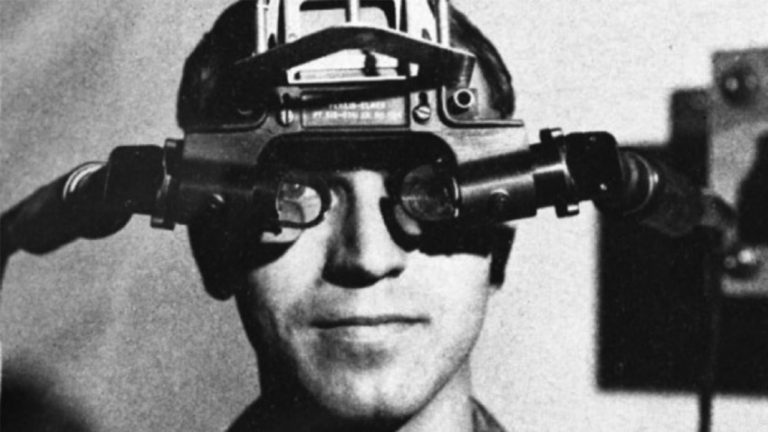Virtual reality is the history of the formation of artificial reality.

Today's virtual reality technologies are based on ideas that go back to the 1800s, almost to the very beginning of practical photography. In 1838, the first stereoscope was invented, which used double mirrors to project a single image. This eventually developed into the View-Master, patented in 1939 and still in production today.
However, the term "virtual reality" was first used in the mid-1980s when Jaron Lanier, founder of VPL Research, began designing the equipment, including goggles and gloves, needed to experience what he called "virtual reality." . ”
1837 - the first stereoscope

The progenitor of all stereoscopic glasses, especially the Google Cardboard, can be considered a device developed by Charles Winston in 1837. The principle of its operation is painfully primitive: two identical flat images are placed inside at different angles, as a result of which the brain perceives it as a three-dimensional picture.
1956 Sensorama

The machine, which looks like a medical device for the study of the fundus, is actually one of the very first 3D displays in the world. It is designed by Professor Morton Heilig and is designed for watching videos. So, in fact, the development of virtual reality began in the 50s of the last century.
Basically, the device was used by amusement parks, as it allowed to experience the experience of immersion in the virtual world, for example, to feel like a biker racing through New York at night, or to be "in the shoes" of a movie character. Such films, by the way, were already produced by companies exclusively for the “sensorama”. In addition to the possibility of projecting stereoscopic video, the device had stereo sound, an autonomous power generator, an odor generator, and even a seat that could vibrate in accordance with what was happening on the “screen”.
1961 Headsight

The device, developed by Philco engineers, became the first mass-produced product in the field of VR. The helmet was the first stereoscopic headset, or as it was then customary to call such gadgets, the first “head-mounted display” (HMD).
The development quickly attracted interest from media companies and security companies. Thanks to the camera installed in the right place, the operator in the helmet could observe what was happening around her. And thanks to the presence of a magnetic tracking system, the helmet transmitted head movement data to the camera, and it changed the viewing angle in accordance with the turn of the head. Thus, military journalists could observe what was happening in hot spots, what is called "around them", without the slightest threat to their own health.
I also want to mention that the creator of Sensorama, Morton Heilig, did not limit himself to just one device and 4 years later, that is, in 1960 he started developing his own VR headset. Unfortunately, due to the loss of confidence and interest on the part of investors, the device did not have time to get on sale, but, fortunately, it was patented. It follows from the drawings that the headset provided for the use of lenses with a viewing angle of 140 degrees, stereo headphones, and even a special nozzle to simulate wind and simulate smells, similar to Sensorama.
1968 - "Sword of Damocles"

The Sword of Damocles system, or in Russian - the Sword of Damocles, was developed by employees of the Lincoln Laboratory at the Massachusetts Institute of Technology. The gadget had a distinctive feature: the developers taught the device, in addition to the ability to broadcast a stereoscopic image and the function of tracking movement in space, also overlay computer graphics on a view of the real world. That is, in fact, this is the first helmet of the augmented reality family.

For those who may not know the differences in these technologies, I will explain: VR (virtual reality) is a complete immersion of a person in a computer-simulated environment, and AR (augmented reality) is a technology for combining objects of the virtual world with the real one. There is also such a term MR (Mixed Reality). The essence of this technology is to bring virtual objects into the real world, where it will be impossible to distinguish a virtual object from a real one. A little later, we will talk about MR devices in this article.

Let's get back to Sword of Damocles. A similar implementation of the projection of 3D objects onto lenses was carried out using a special computer program. It stored a lot of two-dimensional pictures of a 3D object from different angles. They were shown to the viewer in a certain sequence based on the position of the head.

In the video, we can see a demonstration of the work of points using a simple cube as an example:
Like most of these devices, the first version of the glasses was bulky and did not allow you to move freely around the room.
The second version has become much more compact and lighter, since ultrasonic sensors began to be used as sensors for tracking movements instead of magnetic ones.
1980 Eye Tap

The developer of these glasses, and perhaps the progenitor of all wearable electronics, can be considered a Canadian scientist and engineer in the field of computer technology, Steve Mann. While still a school student, young Steve managed to assemble his first portable computer for working with filming equipment, which worked on the basis of the MOS Technology 6502 processor. The entire system could be placed in only one backpack on a metal frame.
The display was assembled from a cathode ray viewfinder from the camera and had a resolution of 40 lines. All this was powered by lead-acid batteries.

Since then, Steve began to improve wearable electronics, and gained real fame thanks to the project of augmented reality glasses, in fact, his development was not much different from the aforementioned Sword of Damocles, but the most important thing lies in the details. Mann managed to use all the possibilities of the beam splitter on the helmet camera as successfully as possible, which made it possible to show the environment both for the average user through the viewfinder and for the system working with the camera on the helmet in order to superimpose virtual objects on the scene in real time.

And besides this, all calculations were carried out by a wearable computer placed in a backpack, thus the engineer was able to prove that virtual and augmented reality technologies do not have to be inconvenient and cumbersome.
I recommend watching his TED Talk on this topic:
1984 - RB2, First VR controllers

The first device that allows you to interact with the virtual world was introduced in 1984. Thanks to the presence of special gloves, acting as a controller, the two players could completely immerse themselves in artificial reality. In addition to observing, they could directly interact directly with computer objects - move, twist and flip them, in general, do almost anything with what is happening on the display of the EyePhone VR headset. Unfortunately, the device did not gain due popularity due to its cost, the price of a complete set with all controllers was $100. There was also a relatively budget option for $50.
1985 - "Virtual Environment Display System"

A year later, with the support of NASA, a VR helmet was released, which in terms of characteristics is not much inferior even to modern devices, and then it had no equal at all. First of all, the developed device was intended for scientific purposes, since thanks to it it was possible to visually explore the surfaces of planets and other space bodies.
The display of the device was liquid crystal and had a diopter with a wide viewing angle, thanks to which the person in it had a unique experience of being in the virtual world.
1990 Virtuality

One of the earliest VR systems for gaming was introduced to the world at Computer Graphics in 1990 by Jonathan Waldern. The first variation (there were two of them) was a familiar helmet with two LCD displays with a resolution of 276 × 372 for each eye.

The second option was literally a whole real arcade machine in which the player could interact with the steering wheel with a virtual racing car, and it was impressive. Despite some success and fame of Virtuality, its sales were not impressive. Over the entire existence of the system, a little more than 50 thousand copies have been sold on the market.
In terms of games, the most popular titles were the shooter Dactyl Nightmare and the aero-sim VTOL.
1992 - CAVE (first virtual reality room)

In 1992, students at the University of Illion presented a prototype room, the walls of which served as reflective screens for the stereo images projected onto them. To be able to feel the effect of presence in virtual reality, it was necessary to wear special glasses with a stereoscope. As expected, the system had a controller for interacting with VR objects and technology for tracking the user's hands and head.

CAVE systems are still used by some companies to this day. Basically, these areas are related to design, training and ergonomics tests. Unlike VR glasses, virtual reality rooms provide the highest quality immersion in the digital world. In general, they are more serious and professional solutions in this industry.

The advantages of CAVE systems over glasses (HMD) are higher image quality, wide field of view, low tracking latency, the ability to see your body and, as a result, the absence of possible loss of coordination and motion sickness.

But for all their merits, such systems cannot be called home systems, since they require a large investment (the cost of such systems can reach several tens of thousands of euros) for specific VR peripherals for tracking. And they also need a specially designated large area to accommodate all the equipment, which is why VR helmets are the best option for exploring digital spaces for home use.
1993 SEGA VR

In 1993, the well-known company SEGA at the CES (Consumer Electronics Show) announced its vision of a VR headset. The prototype device had built-in stereo speakers, two LCD screens, and a $200 price tag.

Despite a large investment in development by Sega, the device never reached the store shelves. According to official statements, the company has managed to achieve an incredible level of realism in the projected image. Therefore, the development and release of the device had to be curtailed, as the company had fears that this could have a negative impact on the worldview of users.
1995 Nintendo Virtual Boy

Nintendo, just like Sega, decided not to stand aside and released a 32-bit console - the Nintendo Virtual Boy. Initially, it was assumed that the headset would have the ability to track head movement, stereo sound, but unfortunately, all these functions did not reach the release and a VR console appeared on store shelves, which has a monochrome screen that displays only red gradations. Because of it, users often noted rapid eye fatigue and bouts of vomiting.

The helmet itself was actually a desktop one, since its ergonomics did not allow you to freely put it on your head, and this clearly did not add to ease of use.


There were catastrophically few games for the console, and all of them were made only in red and black colors. Coupled with the fact that the set-top box cost $180, consumers quickly forgot about it. Unfortunately, Gunpei Yokoi, who was responsible for the development of the notorious Game Boy console, was too quick to decide whether the Virtual Boy was ready to be released to the market.
1999 - VirtuSphere

The name VirtuSphere speaks for itself. A sphere with a diameter of three meters was intended to be played with virtual reality glasses. Having closed in it, the player could move freely, due to the fact that the sphere itself was on a special platform with wheels. This allowed her to spin in all directions.

This level of immersion in the digital world made an impression on investors, but, unfortunately, like most of these devices, VirtuSphere did not find the proper return and did not receive the proper level of funding. The creators managed to sell the last few copies of their work to museums and military bases in time, which is why they still managed not to go into the red.
Several more projects from different companies were presented next, but all as one were unprofitable, and all the attention of developers and consumers was switched to the Internet, which was gaining popularity. Why there was a period of calm in the field of virtual and augmented reality technologies until 2012.
2012 - Oculus VR

If it weren’t for the rapid development of crowdfunding platforms during that period of time, then perhaps we didn’t just not know about such an enthusiast as Palmer Lucky with his vision of modern VR, but we could completely forget about such technology.

Fortunately, this did not happen. Exactly six years ago, Palmer created the most successful fundraising program in history. His project raised nearly $2,5 million from 10 platform users, enabling the development of branded helmets for several years to come.
After the release of the Oculus Rift DK1, the company immediately began to develop the next generation of glasses, equipping them with a much better screen and ergonomic design. The success of the second generation has generated increased interest in VR headsets from developers and investors.

In 2015, Facebook bought Palmer Lucky's company for $2 billion, which only provided Oculus with the future and financial freedom to develop a proprietary hardware and software complex and confirmed the importance of VR technologies in the future.


Later, their versions of VR glasses were presented by companies such as Lenovo, HTC and Sony for the branded Playstation console. Now let's talk a bit about augmented and mixed reality headsets.
2013 - Google Glass

Shortly before Microsoft, in February 2013, Google introduced its own augmented reality glasses. According to the engineers, testing of the glasses began a year before the release, and development comes out even earlier.

The device was controlled using voice commands, or using a touch panel located on the right side of the glasses. The first versions of the device had on board a dual-core Cortex A9 processor with a frequency of 1,2 GHz manufactured by Texas Instruments, 2 GB of RAM, Wi-Fi, Bluetooth and a GPS receiver, an accelerometer, a 16 GB permanent memory unit, a 5 megapixel camera, and more a projector display with a resolution of 640×360 pixels and even a battery that provides a full day of battery life in moderate use.

Unlike Hololens, the Glass display occupied only the upper right side, and functionally, the glasses could only show notifications and Google Now cards, which could be configured in the client application for glasses on a smartphone, or through a web service. The device did not have a depth sensor, so it could not scan the space around the user, and as a result, could not place digital objects in the real world. This is the difference between augmented and mixed reality glasses, since Glass could not use the environment as a workspace, unlike Hololens.
Later, an updated glasses model was introduced, with double the amount of RAM and a branded application store.
In 2015, the company announced a freeze on the production of glasses, as well as the withdrawal of project development from the walls of the Google X laboratory.
2015 - Microsoft Hololens

One of the very first, successful mixed reality helmets can be considered Microsoft Hololens, presented to the press in January 2015.

The pre-device technology is Kinect, which was released for the Xbox 360 console. Therefore, among the entire HoloLens development team, there are a huge number of those who used to work on Xbox and Kinect. The first batch of devices went on sale on March 16, 2016 for developers exclusively for the USA and Canada with a price tag of $3. Due to the fact that the product was not mass-produced, the company refused the services of vendors and was engaged in their production independently, at a personal factory in the USA. Later it became possible to buy in the UK, France, New Zealand, Australia and Germany.

Inside the device, we managed to place a motherboard on which there is a 32-bit Intel Atom x5 processor, a separate proprietary chip responsible for processing holograms - Microsoft: Holographic Processing Unit, RAM and flash memory units, a graphics processor and Wi-Fi modules, bluetooth. Also on the case there was a place for cameras that scan the space with a viewing angle of 120 degrees, and a speaker system.

Most of all, the device was struck by the optical system for projecting images onto lenses. The lenses have special microcells on them, which in turn refract photons emitted by a special “light engine” projector. Roughly speaking, the beams of light emanating from it move between the layers of lenses at high speed, which makes it possible to produce high quality graphics.
The next difference between Hololens and all HMD displays is that they do not require connection to a computer or smartphone to work, unlike the same Oculus Rift or HTC Vive, since the glasses have a special block for computing and a 16 500 mAh, providing 2-3 hours of continuous battery life.
VR in smartphones

It is worth remembering the sensation from Google. In 2014, the company showed the cheapest VR helmet for smartphones with a cardboard casing. The device was intended for those who just want to get acquainted with the world of digital reality. Its cost was about $10-20. Later, instructions appeared where the craftsmen themselves, or with the help of 3D printers, made similar devices for smartphones.

In 2015, Samsung introduced a headset exclusive to its Samsung Galaxy line of devices - Gear VR, developed in conjunction with the aforementioned industry masters - Oculus. Its cost was about $100.

Hence, I have a feeling that virtual, augmented and mixed reality technologies will be more and more tightly integrated into our lives every year, thanks to the rapidly developing hardware in smartphones.
Modern virtual reality equipment is indebted to the pioneering inventors of the past six decades, who have paved the way for low-cost, high-quality devices that are readily available. Be sure to visit the VR flight simulators at the Franklin Institute to experience the virtual environment for yourself!







